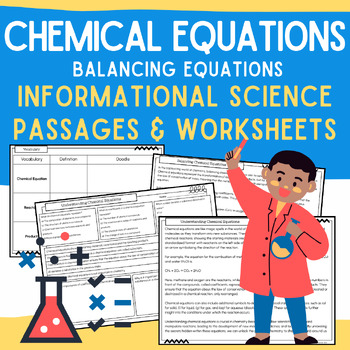Chemical Equations & Balancing Equations: Informational Passages & Worksheets
Enhance SEL
576 Followers
Grade Levels
5th - 12th, Homeschool
Subjects
Resource Type
Standards
NGSS5-PS1-3
NGSSHS-PS1-1
NGSS5-PS1-1
NGSSHS-PS1-7
NGSSMS-PS1-5
Formats Included
- PDF
Pages
15 pages
Enhance SEL
576 Followers
Description
Chemical Equations: 4 Passages, Worksheets, Vocabulary Pages, Answer Keys, and a Bonus SEL & Life Skills Activity
- Dive deep into the world of chemical equations and balancing equations with 4 comprehensive informational passages and accompanying worksheets, offering various forms of questions to reinforce learning.
- Vocabulary pages provided for students to write definitions and doodle a picture, enhancing their understanding of key terms.
- Answer keys included for easy self-assessment and grading, ensuring thorough comprehension of the material.
- Bonus SEL & life skills activity provided for FREE, promoting holistic development alongside academic growth.
Similar Resources:
Physical & Chemical Properties
Total Pages
15 pages
Answer Key
Included
Teaching Duration
N/A
Last updated 3 months ago
Report this resource to TPT
Reported resources will be reviewed by our team. Report this resource to let us know if this resource violates TPT’s content guidelines.
Standards
to see state-specific standards (only available in the US).
NGSS5-PS1-3
Make observations and measurements to identify materials based on their properties. Examples of materials to be identified could include baking soda and other powders, metals, minerals, and liquids. Examples of properties could include color, hardness, reflectivity, electrical conductivity, thermal conductivity, response to magnetic forces, and solubility; density is not intended as an identifiable property. Assessment does not include density or distinguishing mass and weight.
NGSSHS-PS1-1
Use the periodic table as a model to predict the relative properties of elements based on the patterns of electrons in the outermost energy level of atoms. Examples of properties that could be predicted from patterns could include reactivity of metals, types of bonds formed, numbers of bonds formed, and reactions with oxygen. Assessment is limited to main group elements. Assessment does not include quantitative understanding of ionization energy beyond relative trends.
NGSS5-PS1-1
Develop a model to describe that matter is made of particles too small to be seen. Examples of evidence could include adding air to expand a basketball, compressing air in a syringe, dissolving sugar in water, and evaporating salt water. Assessment does not include the atomic-scale mechanism of evaporation and condensation or defining the unseen particles.
NGSSHS-PS1-7
Use mathematical representations to support the claim that atoms, and therefore mass, are conserved during a chemical reaction. Emphasis is on using mathematical ideas to communicate the proportional relationships between masses of atoms in the reactants and the products, and the translation of these relationships to the macroscopic scale using the mole as the conversion from the atomic to the macroscopic scale. Emphasis is on assessing students’ use of mathematical thinking and not on memorization and rote application of problem-solving techniques. Assessment does not include complex chemical reactions.
NGSSMS-PS1-5
Develop and use a model to describe how the total number of atoms does not change in a chemical reaction and thus mass is conserved. Emphasis is on law of conservation of matter and on physical models or drawings, including digital forms, that represent atoms. Assessment does not include the use of atomic masses, balancing symbolic equations, or intermolecular forces.


